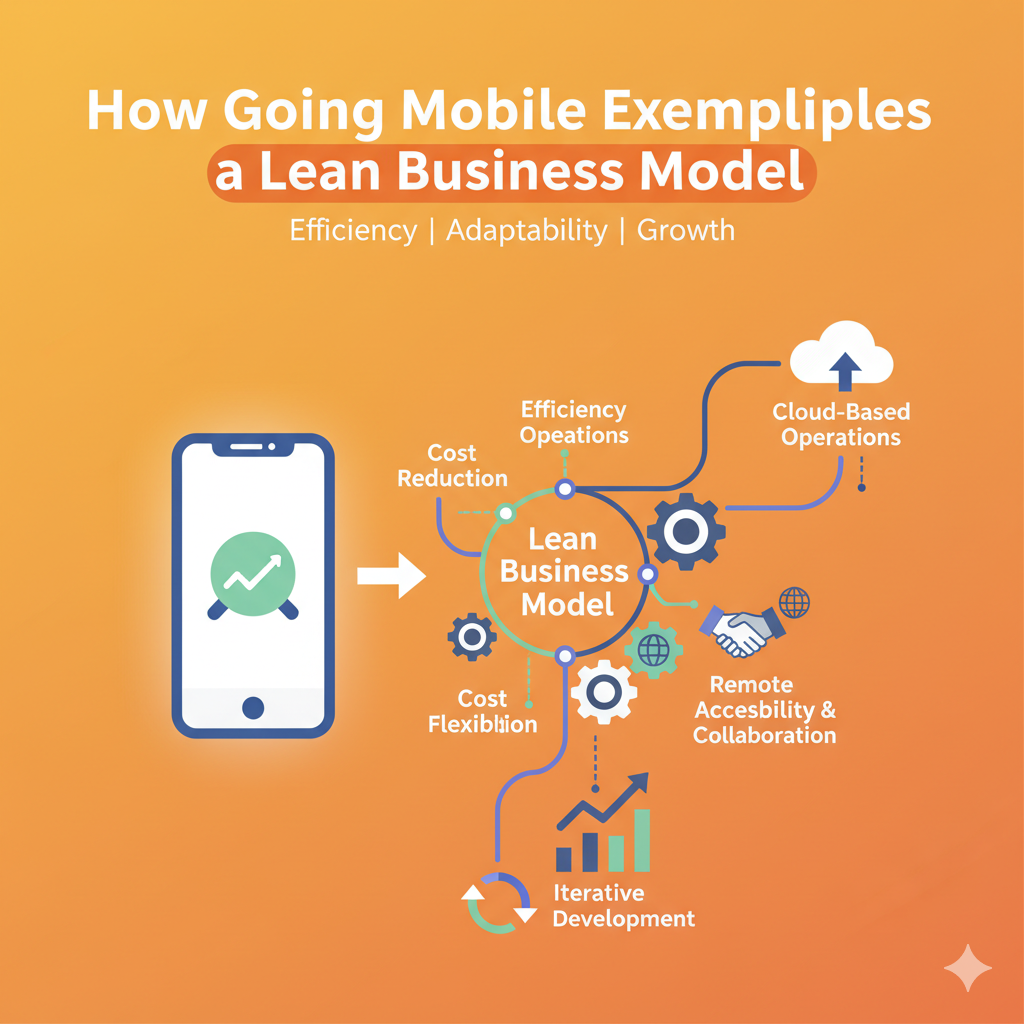When we talk about building a lean business model, most people imagine reducing expenses, streamlining operations, or cutting unnecessary steps. But what if I told you that going mobile whether it’s adopting mobile-first marketing, launching a mobile app, or using mobile tools for operations can actually be a lean strategy in itself?
In today’s fast-moving digital world, mobile technology isn’t just an option; it’s a foundation for efficiency, agility, and scalability. Let’s unpack how going mobile perfectly aligns with the lean business model and why it’s becoming a must-have for modern entrepreneurs.
Understanding the Lean Business Model
Before we dive in, let’s quickly understand what a lean business model actually means.
A lean model focuses on maximizing value while minimizing waste. It’s about achieving more with fewer resources—time, money, and manpower by constantly testing, learning, and improving.
The idea originally came from the manufacturing world, especially Toyota’s production system, but it has since evolved into a universal business philosophy. In simpler terms, lean means:
- Focus on what truly adds value to your customer.
- Cut anything that doesn’t.
- Stay flexible, fast, and data-driven.
Now, how does this connect to mobile? Let’s see.
Why Mobile Is Naturally Lean
The mobile approach aligns beautifully with the lean philosophy because mobile platforms force businesses to think smaller, faster, and simpler.
Think about it: when you design for mobile users, you’re automatically focusing on the essentials. You can’t afford to clutter or overcomplicate. The same applies to your business processes when you operate with mobile tools.
Here are a few examples of how mobile thinking fits into lean strategy:
- Limited screen space pushes you to prioritize what matters most.
- Instant feedback loops (through analytics and app usage) support quick iteration.
- Cloud-based mobile tools allow lightweight, cost-effective operations.
- Always-connected teams mean faster decisions and fewer delays.
In short, going mobile helps you stay lean by enforcing simplicity and speed.
Mobile Cuts Operational Waste
One of the biggest goals of lean management is to eliminate waste—anything that doesn’t create value for your customer.
Mobile systems help cut waste in several ways:
- Reduced paperwork: Mobile invoicing, CRM apps, and digital forms remove the need for manual processes.
- Faster communication: Teams can collaborate instantly via Slack, WhatsApp, or project management apps.
- On-the-go decision-making: Managers no longer need to be at their desks to approve, analyze, or respond.
For small businesses, this means fewer delays, fewer meetings, and fewer unnecessary steps—all key elements of a lean workflow.
Mobile Enables Continuous Improvement
A core principle of lean methodology is continuous improvement (also called “Kaizen”). Mobile apps and tools make it easier to measure, test, and adapt.
Let’s say you’re running a mobile-first eCommerce business. With real-time analytics, you can track which products perform best, how users interact with your app, and what marketing channels bring in the most conversions.
This instant feedback lets you:
- Identify weak areas quickly
- Test small changes often
- Adjust your strategy without heavy investments
That’s exactly how lean businesses operate—by learning through fast feedback cycles instead of big, risky decisions.
Lower Costs, Higher Reach
Going mobile often costs less than traditional operations. Instead of large physical setups, businesses can use mobile apps, cloud storage, and social platforms to manage customers and sales.
For example:
- A local business can use WhatsApp Business or Instagram to take orders.
- Freelancers can use mobile invoicing tools to get paid instantly.
- Service providers can manage appointments through booking apps.
All these save money on infrastructure and staff, while still reaching a large audience. This low-cost, high-impact approach perfectly represents lean thinking.
Mobile First = Customer First
Lean businesses put customers at the center of every decision. And in today’s world, customers live on their phones.
By going mobile, you’re meeting your customers exactly where they are. You’re making it easier for them to interact, buy, and engage with your brand.
A mobile-friendly business:
- Offers convenience
- Provides faster responses
- Simplifies the user journey
That means fewer friction points and more satisfied customers, which ultimately leads to better retention—one of the biggest goals of any lean system.
Agility and Flexibility in Real Time
A lean business must be agile—able to adapt quickly to changes. Mobile tools provide this flexibility better than any other medium.
Whether it’s adjusting a marketing campaign, responding to customer feedback, or tracking KPIs on the go, mobile systems allow real-time action.
For instance:
- You can update product listings instantly from your phone.
- Track social media performance and tweak content immediately.
- Use mobile dashboards to monitor revenue or inventory anywhere.
This responsiveness keeps your business adaptive and lean at every level.
Data-Driven Decisions Made Simple
Lean businesses thrive on data, not assumptions. The beauty of mobile technology is that it automatically collects valuable behavioral data.
Mobile analytics tools help you understand how users engage with your app or website—what they like, what they skip, and where they drop off.
With this information, you can make smarter, smaller, and faster decisions—without relying on guesswork or long research cycles.
In short, going mobile turns every interaction into insight.
Case Example: Small Retailer Going Mobile
Imagine a small retailer that used to rely on a physical shop and paper-based sales tracking. By adopting a mobile-first approach—using Shopify’s mobile app, digital payment solutions, and online customer service—the owner can:
- Track real-time sales data
- Manage inventory from a phone
- Communicate instantly with customers
- Run social media promotions directly
What used to require multiple systems or staff now happens from one device. That’s the lean mindset in action: simplified, efficient, and customer-focused.
Going Mobile Helps You Scale Without Heavy Costs
Traditional scaling often means higher costs—more staff, more equipment, more rent. Mobile helps you scale digitally, without big overheads.
For example, an online business can expand to new markets through mobile advertising and global app distribution, rather than setting up new branches.
This type of digital scalability aligns perfectly with the lean model because it focuses on resource efficiency and incremental growth.
Challenges of Going Mobile (and How to Handle Them)
Of course, going mobile isn’t a magic bullet. It comes with challenges too:
- Security risks due to data exposure
- App performance issues
- User experience limitations on small screens
But these can be managed with lean principles—testing, feedback, and iteration. Start small, gather real user insights, and improve gradually. Avoid overbuilding or chasing perfection on day one.
That’s how you stay truly lean while going mobile.
Conclusion
Going mobile isn’t just a technology trend it’s a business strategy that embodies the lean philosophy. It’s about doing more with less, staying close to your customers, and continuously improving based on data and feedback.
When you think of mobile as more than a tool as a mindset you realize it encourages the same values that make lean businesses successful: simplicity, efficiency, and adaptability.
So if you’re planning to make your business leaner, start by looking at your mobile opportunities. Because in many ways, mobile-first is the new lean.

